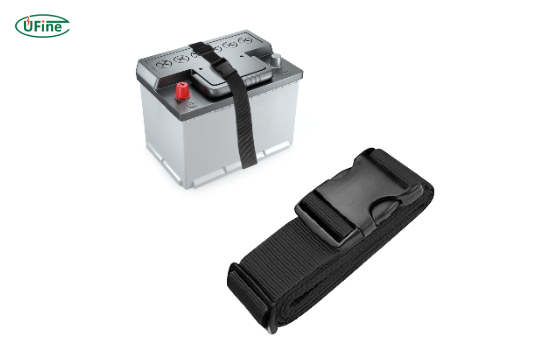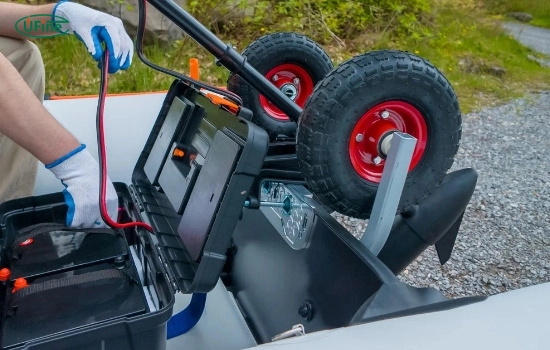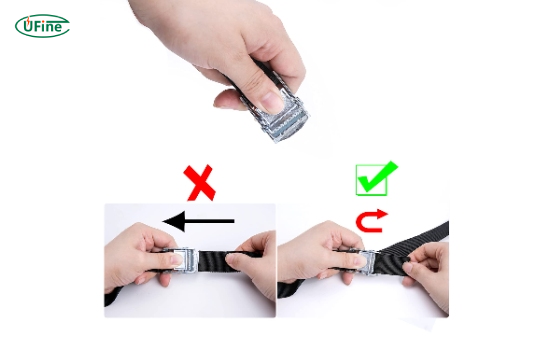
- Part 1. What is a battery strap down?
- Part 2. Why battery strap downs matter for lithium and lifepo4 batteries
- Part 3. Types of battery strap downs
- Part 4. How to choose the right battery strap down? (Step-by-Step Guide)
- Part 5. Installation guide: How to secure a battery properly?
- Part 6. Notes for lithium battery manufacturers (OEM/ODM Considerations)
- Part 7. Conclusion
Battery systems operate in environments that are constantly exposed to vibration, movement, impact, and temperature shifts. Whether used in portable electronics, RV systems, solar storage, marine applications, or high-power LiFePO4 energy systems, a secure mounting solution is essential to maintain performance and safety. That’s where the battery strap down comes in—a simple but critical device that keeps a battery firmly in place and prevents both mechanical and electrical damage.
This guide explains what a battery strap down is, why it is especially important for lithium and LiFePO4 batteries, and how to choose the right strap down based on size, material, application, and installation requirements.
Part 1. What is a battery strap down?
A battery strap down is a flexible securing device—typically made from nylon webbing, rubber, Velcro, or metal—that wraps around the battery to hold it tightly to a mounting tray or base. Unlike rigid hold-down brackets, strap downs conform to the battery’s shape, provide vibration damping, and allow quick installation or removal.
1 How it compares with other mounting methods
- Strap Down: Flexible, adjustable, absorbs vibration
- Hold-Down Bracket: Rigid, more permanent, load-bearing
- Battery Tray: Supports the battery but requires a strap or bracket for full restraint
2 Advantages of strap downs
- Adapts to different battery sizes
- Better vibration absorption
- Lightweight and corrosion-resistant
- Protects soft-pack and plastic-case lithium batteries
- Easy to install in compact spaces
Part 2. Why battery strap downs matter for lithium and lifepo4 batteries
Lithium batteries behave differently from lead-acid batteries. Their internal structure, terminals, and enclosure materials make them more sensitive to vibration and compression, making proper mounting essential.
Below are the main reasons lithium batteries require reliable strap down systems.
1 Vibration Can Cause Internal Fatigue
Inside a lithium or LiFePO4 battery, the cell tabs, BMS connections, and welding points are more delicate than the lead-acid counterparts. High or continuous vibration can lead to:
- Welded joints loosening
- Cell interconnect fatigue
- Increased internal resistance
- Accelerated capacity degradation
Consistent vibration is one of the major causes of early lithium battery failure in RVs, boats, forklifts, and off-road equipment.
2 Horizontal Movement Can Damage Soft-Pack Cells
Soft-pack (pouch) cells are especially vulnerable. If a battery slides or shifts repeatedly:
- The aluminum-laminate pouch can wear through
- Internal layers may deform
- Risk of short circuit increases
- Structural integrity is compromised
A strap down eliminates this risk by keeping the battery firmly fixed.
3 Lithium Cells Expand Slightly with Temperature
Lithium cells can expand during charge/discharge or under temperature changes.
A good strap down should therefore:
- Maintain secure tension
- Absorb slight expansion
- Avoid compressing the battery excessively
Flexible nylon or rubber straps are preferred for this reason.
4 Battery Terminals Become Unstable When the Battery Moves
Lithium terminals are often attached directly to bus bars or BMS wiring. When the battery moves:
- Terminal bolts may loosen
- Contact resistance increases
- Terminals can overheat
- Arcing or melting can occur
Proper strap downs prevent these issues by reducing mechanical stress on terminals.
5 Compliance With Marine / RV / Mobile Safety Standards
For many installations, strap downs are not optional—they are required.
- ABYC standards for boats
- RVIA guidelines for RV systems
- Off-road vibration test requirements
Using certified strap downs is essential for ensuring compliance.
Part 3. Types of battery strap downs
Battery strap downs come in different materials and designs. Choosing the right type depends on vibration level, environment, and the battery’s surface material.
1 Nylon Strap Down (Most Common & Versatile)
Benefits:
- High tensile strength
- UV-resistant
- Flexible and lightweight
- Works for 3.7V–48V lithium battery packs
Nylon straps are widely used in RVs, solar systems, and portable energy storage.
2 Rubber Strap Down (Superior Anti-Slip Performance)
Best for:
- Marine environments
- Wet or high-vibration conditions
- Industrial machinery
Rubber straps offer strong grip and corrosion resistance.
3 Velcro Strap Down (For Small Lithium Packs)
Best for:
- Wearable devices
- Compact IoT electronics
- Lightweight battery packs
Velcro straps are not recommended for high-vibration environments.
4 Metal Strap Down (For Large Battery Cabinets)
Best for:
- Battery enclosures
- Industrial and telecom energy modules
- Heavy stationary systems
Metal brackets must be used carefully around soft-pack lithium cells to avoid compression damage.
Part 4. How to choose the right battery strap down? (Step-by-Step Guide)
Below is a practical selection guide designed for installers, engineers, and lithium battery users.
1 Step 1. Choose Strap Width and Length Based on Battery Size
Recommended widths:
- Small lithium cells (<1Ah): 15–20 mm
- Medium battery packs (7.4V, 12V, 20Ah): 25–30 mm
- Large LiFePO4 (50Ah–200Ah): 38–50 mm
Strap length should allow 20–30% adjustment margin.
2 Step 2. Match the Material to the Environment
| Application Scenario | Recommended Material |
|---|---|
| General RV / solar | Nylon |
| Marine | Rubber / Stainless steel |
| Off-road ATV | Nylon with anti-slip pads |
| Small portables | Velcro |
3 Step 3. Ensure Compatibility With LiFePO4 Casing
When selecting a strap for LiFePO4 batteries, confirm that it:
- Doesn’t compress terminals or BMS modules
- Doesn’t block thermal vents
- Avoids sharp contact points
- Doesn’t create excessive pressure
Metal straps should include rubber padding to protect the casing.
4 Step 4. Consider Thermal Expansion
Lithium cells need minor breathing space.
A properly tensioned strap down should:
- Hold the battery firmly
- Still allow slight vertical expansion
- Avoid rigid over-compression
5 Step 5. Meet Industry Safety Standards
Different industries have different strap requirements:
- Marine → Stainless buckles + corrosion-resistant webbing
- RV → Strap must pass vibration stability tests
- Solar → Must withstand outdoor UV & temperature cycles
- Industrial → High-temperature and chemical resistance
6 Step 6. Use a Battery Tray Together With the Strap Down
A strap down secures the battery, while a tray:
- Provides a stable base
- Prevents sliding
- Distributes pressure evenly
Both components together achieve maximum safety.
Part 5. Installation guide: How to secure a battery properly?
A correct installation extends battery life and ensures system safety.
1 Standard installation procedure
- Clean the mounting surface
- Confirm the tray is fixed securely
- Thread the strap through tray slots
- Wrap the strap around the battery
- Apply firm, even tension
- Leave a slight buffer for expansion
- Check the buckle lock
- Test for movement before powering on
Part 6. Notes for lithium battery manufacturers (OEM/ODM Considerations)
For manufacturers producing 3.7V, 7.4V, 12V, 24V, and 48V lithium battery packs, integrating strap-down support into product design increases safety and compatibility.
1 Provide Built-In Strap Down Channels
Especially useful for:
- ABS plastic housings
- Metal-case LiFePO4 modules
- Portable power stations
These channels help installers secure the battery safely.
2 Add Anti-Slip Pads on Top Surfaces
Helps prevent:
- Movement under vibration
- Damage to aluminum cases
- Stress on cell modules
3 Perform Vibration Testing During Battery Development
Recommended parameters:
- 3–5g vibration levels
- Multi-direction profiles
- 2,000–3,000 cycle tests
This ensures the battery tolerates harsh environments.
4 Offer Compatibility Tables for Universal Strap Downs
Helps customers select the correct strap size for your battery models.
Part 7. Conclusion
A battery strap down is a simple but essential device that ensures safe operation, reduces vibration damage, prevents terminal stress, and extends the lifespan of lithium and LiFePO4 batteries. By choosing the right material, matching the strap to the battery size, and installing it correctly, users can significantly improve the reliability of any mobile or stationary energy system.
For manufacturers and system designers, integrating strap-down considerations into product development offers stronger performance, better user safety, and smoother installation across multiple applications.
Related Tags:
More Articles

1.5V Battery Vs. 1.2V Battery: Comparison of Their Differences
Compare 1.2V vs 1.5V batteries: voltage, usage, rechargeability. Best for remotes, toys, cameras. Discover which AA battery suits your device.
Recommended 10 Best Batteries For Smoke Detectors
Discover the best batteries for smoke detectors in 2025. Compare top 10 9V and AA options for long-lasting, leak-proof, and reliable smoke alarm power.
Triple A Battery Voltage: Everything You Need to Know
Learn how many volts are in a triple A battery (1.5V vs 1.2V), see AAA battery voltage chart, and compare chemistry, testing, and lifespan for 2025 devices.
9V vs AA Batteries for Fire Alarm: Which One Should You Use?
Compare 9V and AA batteries for smoke detectors. Learn which type provides better lifespan, voltage, and cost efficiency to keep your fire alarms reliable.
Flashlight Battery Size: Types, Choosing Tips and FAQs
Explore flashlight battery sizes with an easy chart. Learn what batteries small flashlights use and how to pick 18650, 26650, 14500, or CR123A cells.





